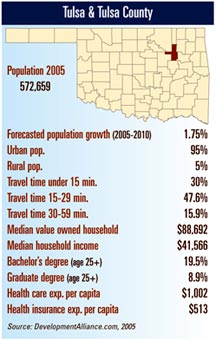
SEPTEMBER 2005
Oklahoma: An Editorial Survey (cover)
Once They Get Here
Textbook Case: Universities and the Telecom Cluster Are on the Same Page (sidebar)
Perception Is Not Reality
How Innovation Becomes Commercialization (sidebar)
Business Climate Brightens
Research Campus Key to City's Health Science Hub (sidebar)
Reporting for Duty; 'Coopetition' Is Key to Aviation Cluster Success (sidebar)
Oklahoma City Re-"MAPS" Its Future (sidebar)
Today's Forecast Calls for a New Industry Cluster (sidebar)
How Tulsa Is Funding a Metropolitan Makeover (sidebar)
Business Cost Advantage
Thank You, Texas
Distribution Center Locations Abound
CSI: Edmond (sidebar)
Making the Workforce Competitive
Wind Joins the
Energy Cluster
A New Day for Oil
and Gas
Pryor Claims Part of the NAFTA Corridor
Request Information

Perception Is Not Reality

|
| Oklahoma's many rivers and lakes belie its "dustbowl" image. |
Changing perceptions of the state is a challenge voiced by industries from scientific (aerospace, biotech and energy exploration) to manufacturing to medicine to the service sector. Once new hires have made the transition from elsewhere, they soon wish they had done so sooner. This may not be the origin of Oklahoma's "Sooner State" nickname, but it's every bit as valid.
"It's harder to recruit to Ardmore, Oklahoma, than it is to La Jolla, California, or Boston," says Michael Cawley, president and CEO of the Samuel Roberts Noble Foundation, an agricultural science and research organization employing more than 300, 70 of whom are Ph.D.s. "But the director of the plant biology division had to replace five post-doctorates this year, and he has not had to recruit for one of those positions. The foundation is now well known enough in this area that people are starting to wait at the door."A key draw to the Ardmore area and elsewhere in Oklahoma is the cost of living — the opportunity to apply one's skills, including high-end agricultural science skills such as those in demand at the Noble Foundation, and enjoy a comfortable lifestyle at the same time. "The cost of living is way cheaper here than it is in a lot of these scientific centers," says Cawley. "You can't buy a home in California if you're a scientist. Once you get them here, they really like it."
Those marketing the state to business and industry define their specific challenge as a lack of an image of the state as a location for business, rather than a negative image. One business leader in the state told Site Selection, "We have a branding issue inasmuch as we have been branded by our disasters — the 1995 Oklahoma City bombing and the occasional tornado."

|
Making matters worse, most peoples' perception of Oklahoma can be traced to their high school American literature course, in which they more than likely read John Steinbeck's "The Grapes of Wrath," chronicling "Okie" farm workers' exodus from the state to California during the Depression. A severe drought in the region did little to improve their plight. Though fiction (in reality, the so-called dustbowl affected only the narrow western panhandle of the state), the book nevertheless left an indelible impression on readers — one that is quickly eradicated on closer inspection.
"So many people enjoyed that book, and if we could get some of them on a plane and bring them to Oklahoma City or Tulsa, then two-thirds of the battle is won," says Dan Ellinor, senior executive vice president at the Bank of Oklahoma, in Tulsa. "Of those who have come, their reaction is almost always the same — it's 'Gee, I didn't know all this was here.'"
"I don't think people quite understand what Oklahoma as a state and Oklahoma City have going for them," adds John Richels, president of Devon Energy Corp., who moved to the state recently from Calgary, Alberta. Devon is one of three major, independent oil exploration and production companies based in Oklahoma City. "It's one of the best kept secrets around as a place in which to do business and to live."